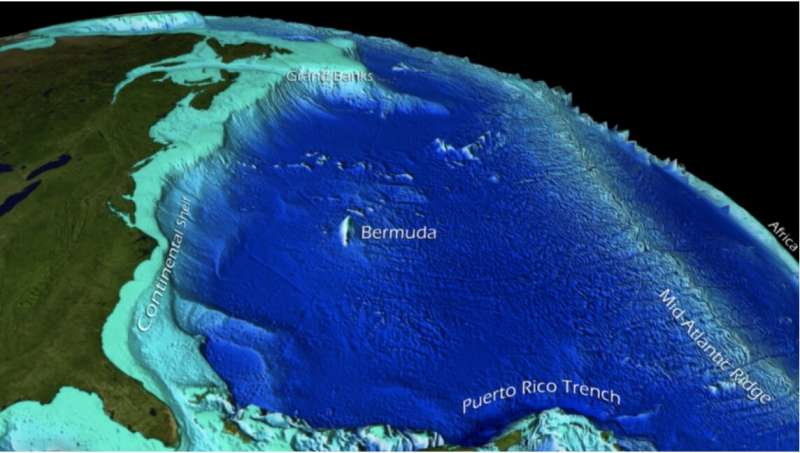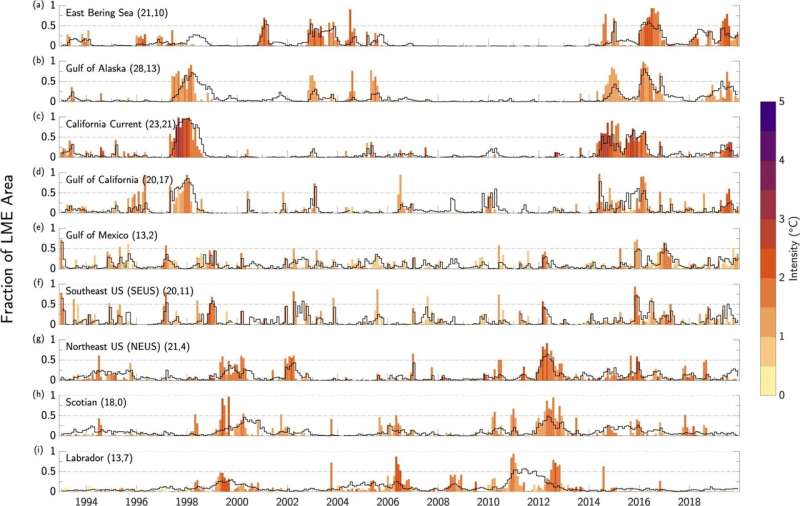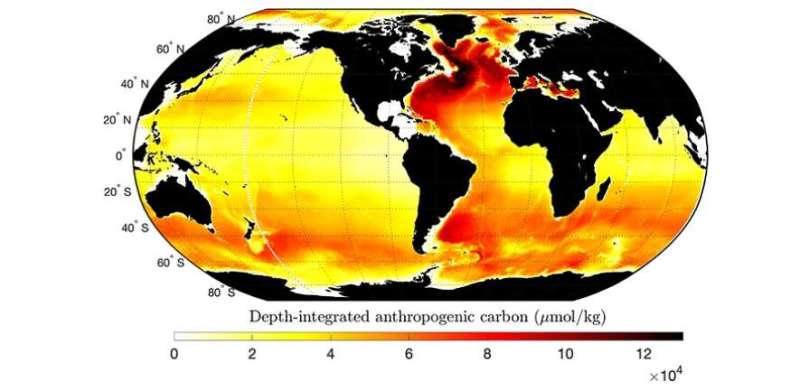Marine heatwaves are sweeping the seafloor around North America
 People bathe in the Pacific Ocean at Agua Dulce beach in Lima, Peru, Wednesday, Feb. 8, 2023. (AP Photo/Rodrigo Abd)
People bathe in the Pacific Ocean at Agua Dulce beach in Lima, Peru, Wednesday, Feb. 8, 2023. (AP Photo/Rodrigo Abd)
Gloria Dickie
Reuters
Staff
Published March 17, 2023
Heatwaves unfolding on the bottom of the ocean can be more intense and last longer than those on the sea surface, new research suggests, but such extremes in the deep ocean are often overlooked.
A team of scientists with the U.S. National Oceanic and Atmospheric Administration have conducted the first assessment of marine heatwaves along North America's continental shelves. Climate Barometer newsletter: Sign up to keep your finger on the climate pulse
They found that these bottom heatwaves ranged from 0.5 degrees Celisus to 3C warmer than normal temperatures and could last more than six months — much longer than heatwaves at the surface.
"We simply don't have a ton of instruments on the ocean bottom along continental shelves," said study co-author Dillon Amaya, a NOAA climate scientist. "The ocean is a powerful thing. It destroys instruments that we have in the water for too long."
Surface heatwaves can be picked up by satellites and can result in huge algal blooms. But, Amaya said, often no one knows a bottom marine heatwave is happening until the impacts show up in commercial bottom-dwelling species like lobsters and crabs.
The assessment, published in the journal Nature Communications, used computer models of the ocean and observations to analyze seafloor heatwaves. It found that while sometimes a marine heatwave can hit both the sea surface and ocean bottom at the same time, bottom heatwaves can also occur on their own.
The ocean has absorbed about 90% of the excess heat from global warming, with the ocean's average temperature increasing by about 0.9C over the last century. Marine heatwaves have become about 50% more frequent over the past decade.
"It's a little less clear if climate change is strongly impacting bottom marine heatwaves in the same way it would at the surface," Amaya said, saying changes to ocean circulation patterns could also play a role.
Past bottom marine heatwaves have decimated Pacific cod and snow crab populations. "Pacific cod in the Gulf of Alaska is an important fishery and … that population has declined by 75% following the big marine heatwave in 2015," said Michael Jacox, a scientist at NOAA's Southwest Fisheries Science Center.
Warmer water, he said, can increase the energy needs of species at the same time that there's less prey available for them to eat, leading to more deaths and fewer births.
(Reporting by Gloria Dickie; Editing by Angus MacSwan)
RELATED STORIESClimate change is creating hungrier, more vicious ocean predators: study
Ocean currents growing weaker due to climate change: Study
Climate change is preventing ocean heat from escaping in Antarctica: McGill study
The slowing down of ocean currents could have a devastating effect on our climate
Canada seeks U.S. buy-in on ocean protection as part of G7 climate initiative: CP
UN ocean treaty talks resume with goal to save biodiversity
Gloria Dickie
Reuters
Staff
Published March 17, 2023
Heatwaves unfolding on the bottom of the ocean can be more intense and last longer than those on the sea surface, new research suggests, but such extremes in the deep ocean are often overlooked.
A team of scientists with the U.S. National Oceanic and Atmospheric Administration have conducted the first assessment of marine heatwaves along North America's continental shelves. Climate Barometer newsletter: Sign up to keep your finger on the climate pulse
They found that these bottom heatwaves ranged from 0.5 degrees Celisus to 3C warmer than normal temperatures and could last more than six months — much longer than heatwaves at the surface.
Surface heatwaves can be picked up by satellites and can result in huge algal blooms. But, Amaya said, often no one knows a bottom marine heatwave is happening until the impacts show up in commercial bottom-dwelling species like lobsters and crabs.
The assessment, published in the journal Nature Communications, used computer models of the ocean and observations to analyze seafloor heatwaves. It found that while sometimes a marine heatwave can hit both the sea surface and ocean bottom at the same time, bottom heatwaves can also occur on their own.
The ocean has absorbed about 90% of the excess heat from global warming, with the ocean's average temperature increasing by about 0.9C over the last century. Marine heatwaves have become about 50% more frequent over the past decade.
"It's a little less clear if climate change is strongly impacting bottom marine heatwaves in the same way it would at the surface," Amaya said, saying changes to ocean circulation patterns could also play a role.
Past bottom marine heatwaves have decimated Pacific cod and snow crab populations. "Pacific cod in the Gulf of Alaska is an important fishery and … that population has declined by 75% following the big marine heatwave in 2015," said Michael Jacox, a scientist at NOAA's Southwest Fisheries Science Center.
Warmer water, he said, can increase the energy needs of species at the same time that there's less prey available for them to eat, leading to more deaths and fewer births.
(Reporting by Gloria Dickie; Editing by Angus MacSwan)
RELATED STORIES
Ocean currents growing weaker due to climate change: Study
Climate change is preventing ocean heat from escaping in Antarctica: McGill study
The slowing down of ocean currents could have a devastating effect on our climate
Canada seeks U.S. buy-in on ocean protection as part of G7 climate initiative: CP
UN ocean treaty talks resume with goal to save biodiversity
Scientists identify heat wave at bottom of ocean

The 2013-2016 marine heat wave known as "The Blob" warmed a vast expanse of surface waters across the northeastern Pacific, disrupting West Coast marine ecosystems, depressing salmon returns, and damaging commercial fisheries. It also prompted a wave of research on extreme warming of ocean surface waters.
But, as new NOAA research shows, marine heat waves also happen deep underwater.
In a paper published in the journal Nature Communications, a team led by NOAA researchers used a combination of observations and computer models to generate the first broad assessment of bottom marine heat waves in the productive continental shelf waters surrounding North America.
"Researchers have been investigating marine heat waves at the sea surface for over a decade now," said lead author Dillon Amaya, a research scientist with NOAA's Physical Science Laboratory. "This is the first time we've been able to really dive deeper and assess how these extreme events unfold along shallow seafloors."
Marine heat waves dramatically impact the health of ocean ecosystems around the globe, disrupting the productivity and distribution of organisms as small as plankton and as large as whales. As a result, there has been a considerable effort to study, track and predict the timing, intensity, duration, and physical drivers of these events.
Most of that research has focused on temperature extremes at the ocean's surface, for which there are many more high-quality observations taken by satellites, ships, and buoys. Sea surface temperatures can also be indicators for many physical and biochemical ocean characteristics of sensitive marine ecosystems, making analyses more straightforward.
About 90% of the excess heat from global warming has been absorbed by the ocean, which has warmed by about 1.5C over the past century. Marine heatwaves have become about 50% more frequent over the past decade.
In recent years, scientists have increased efforts to investigate marine heat waves throughout the water column using the limited data available. But previous research didn't target temperature extremes on the ocean bottom along continental shelves, which provide critical habitat for important commercial species like lobsters, scallops, crabs, flounder, cod and other groundfish.

Due to the relative scarcity of bottom-water temperature datasets, the scientists used a data product called "reanalysis" to conduct the assessment, which starts with available observations and employs computer models that simulate ocean currents and the influence of the atmosphere to "fill in the blanks." Using a similar technique, NOAA scientists have been able to reconstruct global weather back to the early 19th century.
While ocean reanalyses have been around for a long time, they have only recently become skillful enough and have high enough resolution to examine ocean features, including bottom temperatures, near the coast.
The research team, from NOAA, CIRES, and NCAR, found that on the continental shelves around North America, bottom marine heat waves tend to persist longer than their surface counterparts, and can have larger warming signals than the overlying surface waters. Bottom and surface marine heat waves can occur simultaneously in the same location, especially in shallower regions where surface and bottom waters mingle.
But bottom marine heat waves can also occur with little or no evidence of warming at the surface, which has important implications for the management of commercially important fisheries. "That means it can be happening without managers realizing it until the impacts start to show," said Amaya.
In 2015, a combination of harmful algal blooms and loss of kelp forest habitat off the West Coast of the United States—both caused by The Blob—led to closures of shellfisheries that cost the economy in excess of $185 million, according to a 2021 study. The commercial tri-state Dungeness crab fishery recorded a loss of $97.5 million, affecting both tribal and nontribal fisheries. Washington and Californian coastal communities lost a combined $84 million in tourist spending due to the closure of recreational razor clam and abalone fisheries.
In 2021, a groundfish survey published by NOAA Fisheries indicated that Gulf of Alaska cod had plummeted during The Blob, experiencing a 71% decline in abundance between 2015 and 2017. On the other hand, young groundfish and other marine creatures in the Northern California Current system thrived under the unprecedented ocean conditions, a 2019 paper by Oregon State University and NOAA Fisheries researchers found.
Unusually warm bottom water temperatures have also been linked to the expansion of invasive lionfish along the southeast U.S., coral bleaching and subsequent declines of reef fish, changes in survival rates of young Atlantic cod, and the disappearance of near-shore lobster populations in southern New England.
The authors say it will be important to maintain existing continental shelf monitoring systems and to develop new real-time monitoring capabilities to alert marine resource managers to bottom warming conditions.
"We know that early recognition of marine heat waves is needed for proactive management of the coastal ocean," said co-author Michael Jacox, a research oceanographer who splits his time between NOAA's Southwest Fisheries Science Center and the Physical Sciences Laboratory. "Now it's clear that we need to pay closer attention to the ocean bottom, where some of the most valuable species live and can experience heat waves quite different from those on the surface."
More information: Amaya, D.J. et al, Bottom marine heatwaves along the continental shelves of North America, Nature Communications (2023). DOI: 10.1038/s41467-023-36567-0. www.nature.com/articles/s41467-023-36567-0
Journal information: Nature Communications
Provided by NCAR & UCAR
Weak winds in the Pacific drove record-breaking 2019 summertime marine heat wave
Giant underwater waves may affect the ocean's ability to store carbon

Underwater waves deep below the ocean's surface—some as tall as 500 meters—play an important role in how the ocean stores heat and carbon, according to new research.
An international team of researchers, led by the University of Cambridge, the University of Oxford, and the University of California San Diego, quantified the effect of these waves and other forms of underwater turbulence in the Atlantic Ocean and found that their importance is not being accurately reflected in the climate models that inform government policy.
Most of the heat and carbon emitted by human activity is absorbed by the ocean, but how much it can absorb is dependent on turbulence in the ocean's interior, as heat and carbon are either pushed deep into the ocean or pulled toward the surface.
While these underwater waves are already well-known, their importance in heat and carbon transport is not fully understood.
The results, reported in the journal AGU Advances, show that turbulence in the interior of oceans is more important for the transport of carbon and heat on a global scale than had been previously imagined.
Ocean circulation carries warm waters from the tropics to the North Atlantic, where they cool, sink, and return southwards in the deep ocean, like a giant conveyer belt. The Atlantic branch of this circulation pattern, called the Atlantic Meridional Overturning Circulation (AMOC), plays a key role in regulating global heat and carbon budgets. Ocean circulation redistributes heat to the polar regions, where it melts ice, and carbon to the deep ocean, where it can be stored for thousands of years.
"If you were to take a picture of the ocean interior, you would see a lot of complex dynamics at work," said first author Dr. Laura Cimoli from Cambridge's Department of Applied Mathematics and Theoretical Physics. "Beneath the surface of the water, there are jets, currents, and waves—in the deep ocean, these waves can be up to 500 meters high, but they break just like a wave on a beach."
"The Atlantic Ocean is special in how it affects the global climate," said co-author Dr. Ali Mashayek from Cambridge's Department of Earth Sciences. "It has a strong pole-to-pole circulation from its upper reaches to the deep ocean. The water also moves faster at the surface than it does in the deep ocean."
Over the past several decades, researchers have been investigating whether the AMOC may be a factor in why the Arctic has lost so much ice cover, while some Antarctic ice sheets are growing. One possible explanation for this phenomenon is that heat absorbed by the ocean in the North Atlantic takes several hundred years to reach the Antarctic.
Now, using a combination of remote sensing, ship-based measurements and data from autonomous floats, the Cambridge-led researchers have found that heat from the North Atlantic can reach the Antarctic much faster than previously thought. In addition, turbulence within the ocean—in particular large underwater waves—plays an important role in the climate.
Like a giant cake, the ocean is made up of different layers, with colder, denser water at the bottom, and warmer, lighter water at the top. Most heat and carbon transport within the ocean happens within a particular layer, but heat and carbon can also move between density layers, bringing deep waters back to the surface.
The researchers found that the movement of heat and carbon between layers is facilitated by small-scale turbulence, a phenomenon not fully represented in climate models.
Estimates of mixing from different observational platforms showed evidence of small-scale turbulence in the upper branch of circulation, in agreement with theoretical predictions of oceanic internal waves. The different estimates showed that turbulence mostly affects the class of density layers associated with the core of the deep waters moving southward from the North Atlantic to the Southern Ocean. This means that the heat and carbon carried by these water masses have a high chance of being moved across different density levels.
"Climate models do account for turbulence, but mostly in how it affects ocean circulation," said Cimoli. "But we've found that turbulence is vital in its own right, and plays a key role in how much carbon and heat gets absorbed by the ocean, and where it gets stored."
"Many climate models have an overly simplistic representation of the role of micro-scale turbulence, but we've shown it's significant and should be treated with more care," said Mashayek. "For example, turbulence and its role in ocean circulation exerts a control over how much anthropogenic heat reaches the Antarctic Ice Sheet, and the timescale on which that happens."
The research suggests an urgent need for the installation of turbulence sensors on global observational arrays and a more accurate representation of small-scale turbulence in climate models, to enable scientists to make more accurate projections of the future effects of climate change.
More information: Laura Cimoli et al, Significance of Diapycnal Mixing Within the Atlantic Meridional Overturning Circulation, AGU Advances (2023). DOI: 10.1029/2022AV000800
Journal information: AGU Advances
Provided by University of Cambridge When winds and currents align, ocean mixing goes deep
No comments:
Post a Comment